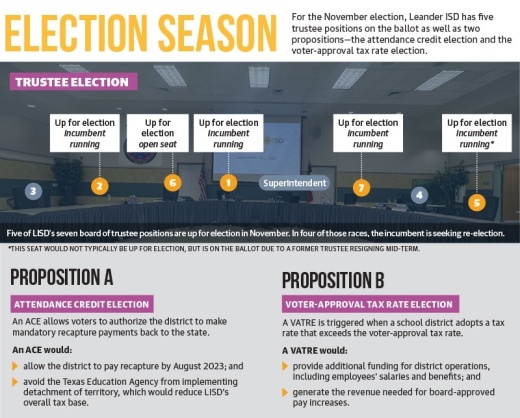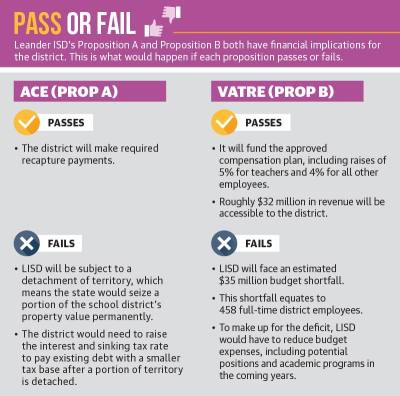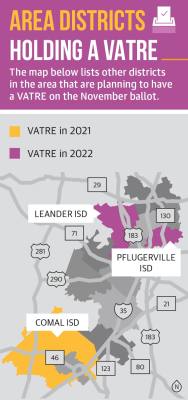More board seats than usual are appearing on the ballot due to a mid-term resignation last year. Additionally, four of the five races up for election have three candidates for a total of 14 candidates, four of whom are incumbents.
Both propositions put before LISD voters pertain to financial issues. The first, the attendance credit election, deals with the district’s required recapture payment; the second, the voter-approval tax rate election, asks voters to approve a tax rate that would provide additional •funding for district operations.
“These elections are critically important, because they allow us to listen to the voice of our community. But, our community needs to make sure that they understand what the propositions are about and what is at stake,” Superintendent Bruce Gearing said. “We urge everybody to educate themselves about these elections that are coming up.”
Board on the ballot
Five of the seven positions on LISD’s board of trustees are on the ballot this November—the highest number of school board positions up for election in more than a decade.
Each of the five races is contested, with four of them drawing three candidates, and incumbents are seeking re-election in four of the five contests.
LISD trustees are elected to four-year terms, and school board elections take place on the November uniform election day in even-numbered years, according to district documents.
Traditionally, this would mean four seats—Places 1, 2, 6 and 7—would be up for election in 2022 after Places 3, 4 and 5 appeared on the ballot in 2020.
However, the resignation of former Place 5 Trustee Jim MacKay in September and the subsequent appointment of Sade Fashokun to the seat means that seat is also up for re-election this year. Fashokun is seeking re-election.
LISD’s longest serving trustee, Aaron Johnson, who was first elected to the board in 2011, announced in July he would not be seeking re-election. Johnson said the reason he is not running again is two-fold: he is tired and frustrated.
“My passion for the issues is no less than it ever has been,” Johnson said. “But, I’m frustrated with our board members and our community and the difficulty many are having in finding common ground. Instead, members of our community are refusing to listen to one another and are trying to rally their base to support their point of view.”
In LISD, some of these divisive issues that have come before the board include the multiyear-long debate over school library and book club books as well as how to handle the district’s finances.
And, LISD’s election comes at a time when school board races across the county have become more political and divisive, said Kay Douglas a senior consultant with the Texas Association of School Boards.
“What’s best for kids should not be partisan,” Douglas said. “That should not enter into making the very best decisions for all of the kids, for all of the community.”
The TASB encourages candidates to run on what they will bring to the table instead of attacking other candidates or district staff, knowing that after the election these groups may have to work together.
Additionally, newly elected board members are required to go through a series of trainings on topics such as open government, improving student outcomes and team-building.
Susan Elliott, director of curriculum and instructional design with the TASB, said when elections bring several new faces, these trainings are especially important so members understand the role of the board and form a team that can govern together.
LISD trustees are elected at-large, meaning each trustee represents the entire district, and all LISD voters will be able to cast a ballot in each race.
“If board members can respect one another’s differences and rise above those differences to focus on the substance that unites them, then I think they’ll be productive and effective,” Johnson said.
Recapture requirements
Proposition A—the ACE—on the November election ballot asks voters to authorize the district to begin making recapture payments back to the state.
“[ACE is] an easy yes, and I think everybody in our community should say ‘yes’ to ACE,” Johnson said. “Because of the laws in Texas, we are required to repay the state—that is, we’ve entered into recapture—and the ACE is just asking the community permission to formally make that payment back to the state.”
Recapture is a function of the amount a public school district receives in tax collections and how much that amount exceeds what the district is entitled to keep based on the number and type of students in the district, former Chief Financial Officer Elaine Cogburn said in an early July interview.
For the first time in eight years, LISD will have to pay $31.2 million back to the state in recapture funds. This will be the district’s highest payment in history.
LISD’s steep recapture payment is due to increased home property values, Cogburn said. Property value growth increased by 27.05% this year.
The district will owe recapture payments every year, Director of Budget and Compliance Gina Mitschke said, because property values are continuing to rise.
If voters approve Proposition A in November, the district will have to make a recapture payment by Aug. 15, 2023, and it will likely be one lump sum payment, Director of Treasury and Debt Management Becky Garcia said.
In the event the ACE fails, LISD will be subject to a detachment of territory, which means the Texas Education Agency could take a portion of the district’s property value and give it to another district.
TEA would take enough property value from LISD to make it so the district is no longer in recapture.
From then on, the district would not receive any revenue from the detached property value, and it will be given to another district instead. Once property is given to another district, it is irreversible, Mitschke said.
LISD would need to raise the interest and sinking tax rate to pay existing debt with a smaller tax base after a portion of territory is detached.
“We want voters to be educated, but it truly is a method of making payment, and if we don’t make that payment, TEA will find a way to get the money,” Mitschke said. “So it’s not going to go away. Whether the VATRE passes or not, we owe recapture. Whether ACE passes or not, we will pay the state in some form.”
Tax rate ramification
In August, when the LISD board of trustees adopted a property tax rate of $1.2746 it triggered a VATRE, which is Proposition B on the November ballot.
The overall tax rate consists of a maintenance and operations rate of $0.9446 and an interest and sinking, or I&S, tax rate of $0.33.
A VATRE requires school districts to seek voter approval to raise its M&O tax rate above a rate set by state law.
LISD’s VATRE would increase the M&O tax rate while lowering the I&S rate—essentially providing the district with more funds for operations, including employee salaries, insurance and benefits.
Despite the fiscal year 2022-23 tax rate being $0.0624 lower than the FY 2021-22 rate of $1.337, the rate approved by the district this year will bring in more revenue to the district because of rising property values.
A successful VATRE would raise the average homeowner's tax bill by $453 annually, while an unsuccessful VATRE will result in a tax bill $72 more than last year's.
The VATRE increases the M&O portion of the rate by $0.0726, and reduces the I&S portion by $0.135.
I&S tax rate finances debt, including that incurred for major capital projects.
If approved, the VATRE could provide LISD with roughly $32 million in revenue, which allows the district to fund approved salary increases and current programs.
If the VATRE fails, the district’s tax rate would be $1.1846 per $100 valuation, with the M&O portion falling to $0.8546. Under this scenario, the district would face a $35 million budget deficit, Mitschke said, which equates to funding necessary for 458 positions.
Gearing said students and staff will not see a direct effect of a failed VATRE in the current school year, as the board-approved 4%-5% compensation increases as well as the deficit will be financed by the district’s built-up fund balance.
However, he said it would affect the budget for years to come.
“From experience, when we looked at budget cuts before, what we tried to do is have as little impact on our student-facing staff as possible,” he said. “But in this scenario there is no way that you can cut $30 million without taking those cuts from all parts of the organization.”
Johnson voted against holding the VATRE due to the district not having money for the pay increases approved in May, of which a passed VATRE would fund. Johnson also voted against the pay increases.
“The budget that was already adopted depends on the passage of the VATRE. This is one of the concerns I had about how this VATRE was structured and how we got to this point,” Johnson said. “I would much prefer that we had gambled less on the VATRE passage, but that’s what the board chose to do.”
Trustee Gloria Gonzales-Dholakia along with four other trustees—who were also in favor of the pay increases—were in support of holding a VATRE despite the possible risks.
“Yes, it’s a gamble ... we’re gambling on our educators. We’re gambling on our community,” Gonzales-Dholakia said at the Aug. 18 meeting. “We’re gambling for this community to come together and support this district that we love.”
Claire Shoop contributed to this report.








